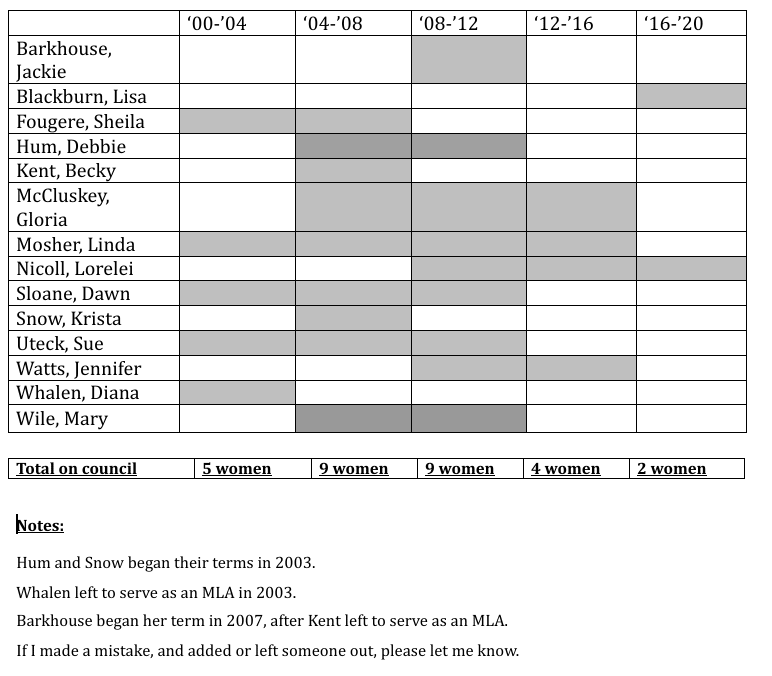
KJIPUKTUK (Halifax) – Let’s have a look at Halifax council today. HRM councillors include: 13 white men, one Black man, and two women. Seriously. And rumour has it that we are in the top fifteen largest cities (by population) in Canada – and the biggest city east of Montreal.
We are about to have our civic election. Winners could reflect the changes and the diversity of our city.
Here are the women who sat on council in the last two decades: the shading represents the terms they were on council.

As earlier noted, for the current term, 2016-20, HRM council had two women (12.5% of councillors).
However, we seem to be going in the wrong direction. Today with two women councilors, we have half the number of women (4) councillors that we had from 2012-16. And in
- 2008-12 there were 9 women on council (more than four times the number we have today) (39%)
- from 2004-08 there were 9 women on council (39%)
- and from 2000-04, we had 5 women on council (21%)
Why have women become so scarce on Halifax Regional Council?
Here are two reasons: First, in 2011 the Council was decreased from 23 to 16 seats in time for the 2012 election. And what do you know?– when seats are scarce, those remaining seats tend to go to men. It’s like the game Musical Chairs. For career reasons, men tend to hang on to their seats and because they have more experience in leadership roles at the workplace and in other organizations, they are often preferred as savvy candidates for city council. Sexism also plays a role.
Secondly, Premier McNeil dissolved school boards in 2018, and health boards (except for one) across Nova Scotia in 2014. Often women ran for trustee positions on school boards, in part because they tend to be involved in their children’s education, and in part because running for the school board was often a first step up the political ladder. Without the ability to test commitment, organizational skills and popularity at the school board level, women have less access to electoral politics. And with McNeil’s scuttling nine district health authorities, women who at one time filled seats at their local health authorities, have no pipeline into other public offices.
In fact, even in Atlantic Canada, Halifax has the second lowest percentage of women councillors — only 12.5%. Only Fredericton has fewer with 8.3% women on their council. This chart shows the percentage of women councilors in selected cities in the region and across Canada –
| Fredericton, NB | 8.3% |
| Halifax, NS | 12.5% |
| Moncton, NB | 20% |
| St John’s, NF | 33% |
| Ottawa, ON | 30% |
| Hamilton, ON | 25% |
| Calgary, AB | 21% |
| Victoria, BC | 42% |
We do have an exceptionally low percentage of women on council, but in keeping with many other cities we also have a low percentage of Black, Brown or Indigenous councilors. Halifax has no noticeably disabled councillors.
All this is to say that when you cast your ballot in 25 days, think about equity. We have five women of colour running for council. And one woman who is physically disabled contesting one district.
As Tim Bousquet wrote in The Coast a decade ago: “We elect councillors so they can represent our concerns at council. If all citizens had the same concerns, and the same point of view on all the issues, then we would only need one councillor for all of HRM. But we live in a diverse municipality…”
Let’s think about the fact that in five terms, since 2000, our council averaged more than 27% women councillors – and today women make up only 12% of councillors. What will it be in a month from now?
See also: Former HRM councillor’s reports of widespread workplace harassment and bullying fell on deaf ears.
Judy Haiven is on the steering committee of Equity Watch, a Halifax-based organization which fights bullying, racism and discrimination in the workplace. You can reach her at equitywatchns@gmail.com
With a special thanks to our generous donors who make publication of the Nova Scotia Advocate possible.
Subscribe to the Nova Scotia Advocate weekly digest and never miss an article again. It’s free!



